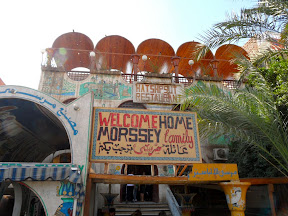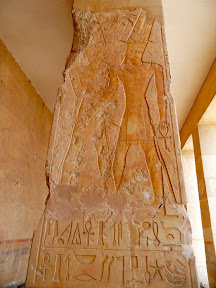We woke early for our first taste of Egypt by day. We all gathered in the entrance lobby of the boat and filed out through the adjoining ships. Even though my cohort was confident and relaxed at the situation, having been to Egypt briefly not six months previous I was still feeling a bit apprehensive, maybe recalling the 'helpful' men from the night before, or perhaps a little of the stereotypical Aladdin-style arabs who may be lurking around the first corner. Of course, no such people existed as we made our way to the coach, but the advice about pickpockets and not straying far from the group that still rang in my ears didn't help matters.
 |
Eventually we made it to the street level and across the dusty tiled pavement to the waiting coaches. In the morning light, the Luxor shorefront looked unloved and broken. Streetlights hung powerless with their shades cracked or missing, traffic lights were almost destroyed by clumsy driving incidents, and many of the shops were boarded up or dusty and lifeless. Men sat or stood scanning the area for tourists, with little else to occupy them. Life carried on in the near absence of tourism as best it could.
 |
Down a short track, two well-worn giant statues of Amenhotep III, one of the kings buried in the valley beyond. They were impressively large although on their own they were difficult to get too excited over. This was clearly anticipated, as a small group of men stood behind stalls or covered in cotton blankets took advantage of the latest set of wandering eyes that began to appear after a few minutes to zero in on a potential sale.
 |
The coach carried down the road for a short while and bore right, and our first sight of the Valley of Kings could be seen to the left. Just beyond a low wall, the stony ground began to gently rise into the distance until ending sharply at the base of a sheer cliff, beyond which stood the Valley of Kings proper. In between was a vast area that looked as if it had been partly excavated by archaeologists, revealing a network of paths between small tunnels in the rocks below, which may have once been homes to those who were burdened with the construction of the scenes we were about to encounter. Off in the distance, we could make out the temples at Deir el-Bahari, and though we didn't know it at the time, the nearby Valley of the Queens nestled among the hills.
 |
Eventually the coach began its trek through the enveloping heaps of excavated stone into the valley. It was at this point that Hani decided to undermine what little confidence we had that we weren't in a potentially dangerous country by telling us that we had to leave our cameras on the coach. Instructions had come down from the intermediate ruling council that all photographs - even when just milling about in the valley looking at large piles of rocks - was forbidden, and that if you did this would get you locked up and in serious trouble. The coach party nervously giggled before realizing Hani wasn't kidding. The last picture I dared to sneak was of the rather lax (and unmanned) security barrier, so how much this was enforced I could not say, but I decided not to take any chances.
The coach stopped in an open parking area, which was peppered sparingly with vendors, milling about waiting for the next band of tourists to pester. Shortly a train-like vehicle - much like those segmented electric powered buggys that take people round a fairground - came along and we all grabbed a seat. Nimbly, and without much concern for their feet, a couple of vendors came along for the ride, straddling the towbars between each segment and stuffing black stone carvings under the nose of anyone who happened to be sitting close enough. We got away without one near us, this time at least.
A little way up - enough for us not to need transportation, although the sun was strong enough for us to appreciate the sentiment - the train stopped and we all got off. Ahead of us was a wide gravel track that disappeared into the distance and merged with the hills on either side. Virtually everything was a dusty chalk colour, save for the signs for the tombs, branching off the main path at several intervals.
Hani gathered us round and gave us a ticket each. This would allow us to see three tombs out of the dozen or so in the valley. They were valid for all the tombs except two of them - the tomb of Ramesses IV, and the most well known one - King Tutankhamun. In order to see them we would need to buy separate tickets, and Hani made clear there would only be enough time to see one of them - and most of us went with his recommendation that we gave the popular but apparently underwhelming King Tut a miss and go see Ramesses IV instead. The extra ones cost about 50 Egyptian Pounds (about £5) each so we were not much out of pocket.
We all followed Hani into the first tomb of Ramesses II as a kind of trainer session. A man stood at the dusty entrance and hole-punched our ticket to make the first of three holes. The tomb pathway burrowed down into the rock at a slight angle, and was protected by a wooden walkway and guardrails to keep us well aware of where we could go. The walls and ceiling closed in as you got further inside, but you had to keep on the conveyor belt - there was much to see and not so much time. We could only briefly marvel at what remained of the ancient depictions of the gods above us.
Outside, and after a short lecture on the place by Hani, we all split up and for the first time proper had to head out on our own into the sparse crowd ahead, made up of equal parts tourist and vendor, the former tracking between tomb entrances or looking up at the enveloping summits above while trying their best to avoid the incessant badgering by the latter. We went together to the tomb of Ramesses IX, and because by then we were all Ramesses-ed out, we headed off to the more remote areas away from the crowds, and chose Pharaoh Setnakhte's tomb, where we fended off the advances of a helpful vendor who thrust his torch into my hand and then tried to charge me for its use on the way out.
To be honest, the tomb tour was one big blur of slightly claustrophobic but beautifully decorated chambers, a mix of the beautiful and the desecrated, both by time and by the careless hands of those who discovered, looted and squatted within them. Without the benefit of pictures to remind us after the fact they merge into one big underground complex - but I would certainly recommend braving the crowds and spending some time there visiting the tombs at hopefully a more leisurely pace than what we had to.
While the missus answered a call of nature I was left alone, and in the midday sun I decided to take shelter under a wooden sit-down area. Curiosity required me to scale a set of steps after a short while that headed upwards to what appeared to be a lofty viewing platform. Several uniformed people could be seen with their feet up at the top already, and just as I was about to climb the steps to join them, a couple of similarly dressed soldier types cheerily went ahead of me. They smiled at me and I said hello to them, and then as they ascended the steps I saw the rather large automatic rifles they were carrying and decided I had perhaps better not follow them.
Our fellow holidaymakers re-assembled back at the meeting point and headed back to the train. Hani took advantage of the no-photos policy to give everyone the chance to purchase a set of pre-approved photocards of the area, at a reasonable price of course. Some people took the bait and handed over their cash.
On the way back to our coach, we got caught by a vendor who hopped on just as we thought we would get away with it. In broken English, he explained to us how it was proper stone rather than fake that he was showing us - a set of black stone scarabs of various sizes - which he proceeded to loudly bang together in front of us as if the fact they made a clacking sound was a sure sign of their authenticity. A few hundred Egyptian pounds was asked for, and since we just weren't interested we said no. And we continued saying no as the train carried on and the amount began to tumble, until by the entrance to the valley, as we were getting back onto the coach, our desperate vendor was asking for fifty just to get rid. But we didn't care, we were just glad we had managed to run our first gauntlet.
 |
 |
 |
 |
Hani gave us a short amount of time to look around and then we were off again, which conveniently gave us a hurry up to either buy or lose out.. and we bought, although with a degree of restraint at least. Ms Plants bought a small alabaster candle-holder, and I got a greeny-bluey fish for my mantlepiece.
 |
The now familiar combination of a short electric train ride and a peppering of persistent vendors greeted us, and then Hani took time out to remind us of his passionate, shrill voice and maybe-accurate facts of the place ahead, and then giving us a short while to see the sights, headed off to the shelter of a nearby cafe where we would meet back up.
The first thing you see after walking the lengthy and barren entrance strip is an orchard - or the petrified remains of one at least. A clutch of trees and plants of foreign climates had been gathered from around the world and planted in neat rows to satisfy the many pharaohs that walked the temple paths. Now, after the gardeners and carers had long since gone and the beautifully manicured trees were left to the parching sun and the dry sand, they were now little more than dark nodules in the ground.
 |
 |
 |
 |
 |
No comments:
Post a Comment